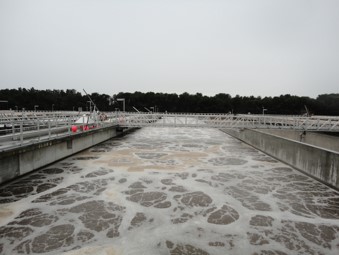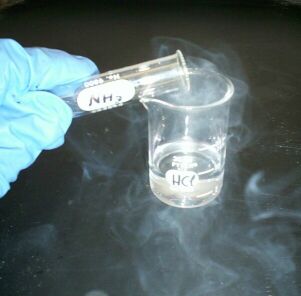|
Activated Sludge
The activated sludge process is a type of biological wastewater treatment process for treating sewage or Industrial wastewater treatment, industrial wastewaters using aeration and a biological floc (biofilm), floc composed of bacteria and protozoa. It is one of several biological wastewater treatment alternatives in secondary treatment, which deals with the removal of biodegradable organic matter and suspended solids. It uses air (or oxygen) and microorganisms to Biological oxidizer, biologically oxidize organic pollutants, producing a waste sludge (or Flocculation, floc) containing the oxidized material. The activated sludge process for removing carbonaceous pollution begins with an aeration tank where air (or oxygen) is injected into the waste water. This is followed by a settling tank to allow the biological flocs (the sludge blanket) to settle, thus separating the biological sludge from the clear treated water. Part of the waste sludge is recycled to the aeration tank and the r ... [...More Info...] [...Related Items...] OR: [Wikipedia] [Google] [Baidu] |
Beckton STP, Activated Sludge Tank - Geograph
Beckton is a suburb in east London, England, located east of Charing Cross and part of the London Borough of Newham. Adjacent to the River Thames, the area consisted of unpopulated marshland known as the East Ham Levels in the parishes of Barking, East Ham, West Ham and Woolwich. The development of major industrial infrastructure in the 19th century to support the growing metropolis of London caused an increase in population with housing built in the area for workers of the Beckton Gas Works and Beckton Sewage Treatment Works. The area has a convoluted local government history and has formed part of Greater London since 1965. Between 1981 and 1995 it was within the London Docklands Development Corporation area, which caused the population to increase as new homes were built and the Docklands Light Railway was constructed. History Toponymy Beckton is named after Simon Adams Beck, the governor of the Gas Light and Coke Company when work building Beckton Gas Works began in Novembe ... [...More Info...] [...Related Items...] OR: [Wikipedia] [Google] [Baidu] |
Spirotrich
The spirotrichs are a large and diverse group of ciliate protozoa. They typically have prominent oral cilia in the form of a series of polykinetids, called the adoral zone of membranelles, beginning anterior to the oral cavity and running down to the left side of the mouth. There may also be one or two paroral membranes on its right side. The body cilia are fused to form polykinetids called cirri in some, and are sparse to absent in others. Forms with cirri are common throughout soil, freshwater, and marine environments. Individuals tend to be flattened, with cirri confined to the ventral surface. These are variously used for crawling over objects, acting as feet, swimming, or assisting in food capture. They are generally divided into hypotrichs and stichotrichs, but were originally all considered hypotrichs. Forms with sparse or absent body cilia tend to be smaller and are mostly marine, but a few are common in freshwater. Again, they are generally divided into oligot ... [...More Info...] [...Related Items...] OR: [Wikipedia] [Google] [Baidu] |
Amoeba
An amoeba (; less commonly spelled ameba or amœba; : amoebas (less commonly, amebas) or amoebae (amebae) ), often called an amoeboid, is a type of Cell (biology), cell or unicellular organism with the ability to alter its shape, primarily by extending and retracting pseudopodia, pseudopods. Amoebae do not form a single Taxonomy (biology), taxonomic group; instead, they are found in every major Lineage (evolution), lineage of eukaryote, eukaryotic organisms. Amoeboid cells occur not only among the protozoa, but also in fungi, algae, and animals. Microbiologists often use the terms "amoeboid" and "amoeba" interchangeably for any organism that exhibits amoeboid movement. In older classification systems, most amoebae were placed in the Class (biology), class or subphylum Sarcodina, a grouping of Unicellular organism, single-celled organisms that possess pseudopods or move by protoplasmic flow. However, molecular phylogenetic studies have shown that Sarcodina is not a monophyletic ... [...More Info...] [...Related Items...] OR: [Wikipedia] [Google] [Baidu] |
Saprotrophic Bacteria
Saprotrophic bacteria are bacteria that are typically soil-dwelling and utilize saprotrophic nutrition as their primary energy source. They are often associated with soil fungi that also use saprotrophic nutrition and both are classified as saprotrophs. A saprotroph is a type of decomposer that feeds exclusively on dead and decaying plant matter. Saprotrophic organisms include fungi, bacteria, and water molds which are critical to decomposition and nutrient cycling, providing nutrition for consumers at higher trophic levels. They obtain nutrients via absorptive nutrition, in which nutrients are digested by a variety of enzymes and subsequently secreted by the saprotroph. Community composition and proliferation rates of saprotrophic indicator bacteria are often considered signals of community health in soil, aquatic, and bodily systems. Structure and life cycle All saprotrophic bacteria are unicellular prokaryotes, and reproduce asexually through binary fission. Variation in the ... [...More Info...] [...Related Items...] OR: [Wikipedia] [Google] [Baidu] |
Organic Matter
Organic matter, organic material or natural organic matter is the large source of carbon-based compounds found within natural and engineered, terrestrial, and aquatic environments. It is matter composed of organic compounds that have come from the feces and remains of organisms such as plants and animals. Organic molecules can also be made by chemical reactions that do not involve life. Basic structures are created from cellulose, tannin, cutin, and lignin, along with other various proteins, lipids, and carbohydrates. Organic matter is very important in the movement of nutrients in the environment and plays a role in water retention on the surface of the planet. Formation Living organisms are composed of organic compounds. In life, they secrete or excrete organic material into their environment, shed body parts such as leaves and roots and after organisms die, their bodies are broken down by bacterial and fungal action. Larger molecules of organic matter can be formed from t ... [...More Info...] [...Related Items...] OR: [Wikipedia] [Google] [Baidu] |
Wastewater
Wastewater (or waste water) is water generated after the use of freshwater, raw water, drinking water or saline water in a variety of deliberate applications or processes. Another definition of wastewater is "Used water from any combination of domestic, industrial, commercial or agricultural activities, surface runoff / storm water, and any sewer inflow or sewer infiltration". In everyday usage, wastewater is commonly a synonym for sewage (also called domestic wastewater or municipal wastewater), which is wastewater that is produced by a community of people. As a generic term, wastewater may also describe water containing contaminants accumulated in other settings, such as: * Industrial wastewater: waterborne waste generated from a variety of industrial processes, such as manufacturing operations, mineral extraction, power generation, or water and wastewater treatment. * Cooling water, is released with potential thermal pollution after use to condense steam or reduce machinery ... [...More Info...] [...Related Items...] OR: [Wikipedia] [Google] [Baidu] |
Flocculation
In colloidal chemistry, flocculation is a process by which colloidal particles come out of Suspension (chemistry), suspension to sediment in the form of floc or flake, either spontaneously or due to the addition of a clarifying agent. The action differs from Precipitation (chemistry), precipitation in that, prior to flocculation, colloids are merely suspended, under the form of a stable dispersion (where the internal phase (solid) is dispersed throughout the external phase (fluid) through mechanical agitation) and are not truly dissolved in Solution (chemistry), solution. Coagulation (water treatment), Coagulation and flocculation are important processes in fermentation and water treatment with coagulation aimed to destabilize and aggregate particles through chemical interactions between the coagulant and colloids, and flocculation to sediment the destabilized particles by causing their aggregation into floc. Term definition According to the IUPAC definition, flocculation is ... [...More Info...] [...Related Items...] OR: [Wikipedia] [Google] [Baidu] |
Aerobic Organism
An aerobic organism or aerobe is an organism that can survive and grow in an oxygenated environment. The ability to exhibit aerobic respiration may yield benefits to the aerobic organism, as aerobic respiration yields more energy than anaerobic respiration. Energy production of the cell involves the synthesis of ATP by an enzyme called ATP synthase. In aerobic respiration, ATP synthase is coupled with an electron transport chain in which oxygen acts as a terminal electron acceptor. In July 2020, marine biologists reported that aerobic microorganisms (mainly), in " quasi-suspended animation", were found in organically poor sediments, up to 101.5 million years old, 250 feet below the seafloor in the South Pacific Gyre (SPG) ("the deadest spot in the ocean"), and could be the longest-living life forms ever found. Types * Obligate aerobes need oxygen to grow. In a process known as cellular respiration, these organisms use oxygen to oxidize substrates (for example sugars and ... [...More Info...] [...Related Items...] OR: [Wikipedia] [Google] [Baidu] |
Nutrients
A nutrient is a substance used by an organism to survive, grow and reproduce. The requirement for dietary nutrient intake applies to animals, plants, fungi and protists. Nutrients can be incorporated into cells for metabolic purposes or excreted by cells to create non-cellular structures such as hair, scales, feathers, or exoskeletons. Some nutrients can be metabolically converted into smaller molecules in the process of releasing energy such as for carbohydrates, lipids, proteins and fermentation products (ethanol or vinegar) leading to end-products of water and carbon dioxide. All organisms require water. Essential nutrients for animals are the energy sources, some of the amino acids that are combined to create proteins, a subset of fatty acids, vitamins and certain minerals. Plants require more diverse minerals absorbed through roots, plus carbon dioxide and oxygen absorbed through leaves. Fungi live on dead or living organic matter and meet nutrient needs from their host ... [...More Info...] [...Related Items...] OR: [Wikipedia] [Google] [Baidu] |
Nitrogen
Nitrogen is a chemical element; it has Symbol (chemistry), symbol N and atomic number 7. Nitrogen is a Nonmetal (chemistry), nonmetal and the lightest member of pnictogen, group 15 of the periodic table, often called the Pnictogen, pnictogens. It is a common element in the universe, estimated at Abundance of the chemical elements, seventh in total abundance in the Milky Way and the Solar System. At standard temperature and pressure, two atoms of the element chemical bond, bond to form N2, a colourless and odourless diatomic molecule, diatomic gas. N2 forms about 78% of Atmosphere of Earth, Earth's atmosphere, making it the most abundant chemical species in air. Because of the volatility of nitrogen compounds, nitrogen is relatively rare in the solid parts of the Earth. It was first discovered and isolated by Scottish physician Daniel Rutherford in 1772 and independently by Carl Wilhelm Scheele and Henry Cavendish at about the same time. The name was suggested by French chemist ... [...More Info...] [...Related Items...] OR: [Wikipedia] [Google] [Baidu] |
Ammonium
Ammonium is a modified form of ammonia that has an extra hydrogen atom. It is a positively charged (cationic) polyatomic ion, molecular ion with the chemical formula or . It is formed by the protonation, addition of a proton (a hydrogen nucleus) to ammonia (). Ammonium is also a general name for positively charged (protonated) substituted amines and quaternary ammonium cations (), where one or more hydrogen atoms are replaced by Organic compound, organic or other groups (indicated by R). Not only is ammonium a source of nitrogen and a key metabolite for many living organisms, but it is an integral part of the global nitrogen cycle. As such, human impact in recent years could have an effect on the biological communities that depend on it. Acid–base properties The ammonium ion is generated when ammonia, a weak base, reacts with Brønsted–Lowry acid–base theory, Brønsted acids (proton donors): : The ammonium ion is mildly acidic, reacting with Brønsted bases to return ... [...More Info...] [...Related Items...] OR: [Wikipedia] [Google] [Baidu] |





